ZFIN Single Box Search Help
Welcome to the ZFIN single box search engine help page!
Introduction to the interface
Search Home Page | Search Results Page |
Advanced search options
Go directly to top search result (!!)
Adding "!!" as a prefix to your search terms will take you directly to the page of the top search result . For example searching all categories with the search string "pax2a" will find all the records in ZFIN that have been indexed to the string "pax2a". The top result is the record for the pax2a gene page. Searching all categories with the search string "!!pax2a" skips the search results page and takes you directly to the page of the top search result, in this case the pax2a gene page. So, if you know exactly which page you want to go to, using the !! prefix can often streamline your navigation by taking you directly to that page.
Wildcard characters (* or ?)
The “*” character can be used as a wildcard. It replaces one or more characters in a word. It can be used at any position in a word.
Example: A search for “bmp2*” in the Gene category returns the genes “bmp2a”, “bmp2b” and “bmp2k”.
The “?” character can also be used as a wildcard character in searches, but replaces exactly one character. The “*” character can replace multiple characters.
Example: A wildcard search with “bmp?a” in the Gene category will return the bmp1a, bmp2a, bmp7a, and bmp8a genes. But a wildcard search with “bm?a” will not return any genes. A wildcard search with “bm*a” in the Gene category will return multiple genes, including bmp1a, bmp2a, bmp7a, bmp8a, bmpr1aa and bmi1a.
Boolean logic
Boolean operator AND (alternative symbol &&): Requires that both terms on either side of the Boolean operator be present for a match.
Example: “bmp2a AND bmp2b” only returns results that contain both “bmp2a” and “bmp2b”.
Boolean operator OR (alternative symbol ||): Requires that either term (or both terms) on either side of the Boolean operator be present for a match.
Example: “bmp2a OR bmp2b” returns results that contain the terms “bmp2a” or “bmp2b” or both.
Boolean operator NOT (alternative symbol !): Excludes results that contain the term following the NOT.
Example: “bmp2b NOT bmp2a” only returns results that contain the word “bmp2b” but do not contain the word “bmp2a".
Exclusion (-) and inclusion (+)
“-“ before a word excludes results that contain that word. This option is similar to the Boolean NOT operator.
Example: A search for “–GFP” will only return results that do not contain the word “GFP”.
“+” before a word requires that word to be present in all the results returned.
Example: A search for “+dmd” will only return results that contain the word “dmd”.
Use of quotes
Search for a phrase by surrounding it in double quotes. Only results that contain the phrase will be returned.
Example: A search for “toxicological assessment” with quotes will return results that contain only that phrase. A search for “toxicological assessment" without quotes will return more results, as it will include any document that contains both words, regardless of the location of the words with respect to each other.
Escaping special characters by using a backslash “\”
Some characters such as "(" , "?" or "+" have special meaning when they appear in a search query. To have the search interpret a special character literally, precede the character with a backslash. The ZFIN search interface can handle many of these special characters, but if you are not finding the results you expect, try the search with a backslashes before the special characters.
Further documentation
Further documentation on advanced query syntax options can be found on the Lucene query parser syntax documentation page or the Apache Solr reference guide .
FAQ
What is sorting by "Relevance"?
How do I find reporter expression patterns?
How is this search different from the previously existing searches on ZFIN?
The new single box search is smarter, faster, and more flexible than our previous search. For example, if you search for genes expressed in the eye, you will find genes expressed in the eye or any of it's parts, such as the retina. If you search for phenotypes involving the hematopoietic system, you will find phenotypes affecting erythrocytes and other anatomical structures that are part of the hematopoietic system. See the "Advanced Search Options" section of this help page to learn about additional search features including the use of wild cards and boolean logic in queries.
What is a "Fish"?
A Fish is a genotype plus experimental conditions such as morpholinos, TALENS, or CRISPRs that modify the genetic aspect of an experiment.How do I find antibodies that label an organelle?In the Antibody category, use the "Labeled Structure" filter to find and select the organelle of interest. Only anatomical structures and organelles that have expression data in your result set will be shown in the filter. After selecting the organelle, each antibody in the results will have expression data in that structure.
How do I find a genes expressed in a particular anatomical structure at a specific stage?
How do I exclude terms from my search?
In search boxes, preceding a word by a minus sign will eliminate results from your search if they are related to that word. For example, a search for "-pax2a" will find all results that are not related to pax2a. When selecting filter values, choosing the minus that pops up when you hover over the filter value will remove any result that has that value in it.
How often is the search index updated?
The search index is updated daily with new data from ZFIN.

